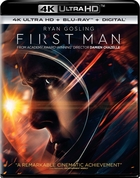BLU-RAY REVIEW

First Man 4K Ultra HD
Featured In Issue 236, February 2019
"First Man" is the story behind the first manned mission to the moon, focusing on Neil Armstrong and the decade leading to the historic Apollo 11 flight. A visceral and intimate account told from Armstrong's perspective, the film explores the triumphs and the cost––on Armstrong, his family, his colleagues and the nation itself––of one of the most dangerous missions in history. (Gary Reber)
Special features include commentary with Director Damien Chazelle, Screenwriter Josh Singer and Editor Tom Cross; two deleted scenes (HD 04:17); eight featurettes: "Shooting For The Moon" (HD 03:40), "Preparing To Launch" (HD 03:39), "Giant Leap In One Small Step" (HD 04:31), "Mission Gone Wrong" (HD 02:42), "Putting You In The Seat" (HD 07:09), "Re-creating The Moon Landing" (HD 06:01), "Shooting At NASA" (HD 03:11) and "Astronaut Training"; upfront previews (Blu-ray); and a Movies Anywhere digital copy code.
The 2.39:1/1.90:1 2160p HEVC/H.265 Ultra HD HDR10/Dolby Vision picture, reviewed on a Sony Bravia Z9D 4K Ultra HD HDR display, was photographed on Kodak Vision3 film stock in Super 16 mm, Super 35 mm and 65 mm with segments in Techniscope and VistaVision using Aaton and Arricam and Arriflex camera systems and sourced from a 2K (not 4K) master Digital Intermediate format. As the 2K Digital Intermediate has been upconverted to 2160p, there is no real gain in native resolution. The picture appears prominently filmic throughout and presents a varied aspect ratio. This is a 1960's period presentation with a color palette that is rich and warm, as well as nicely saturated. Closeups of fleshtones reveal variations in tone. The color grading captures the dull gray lunar surfaces. Colors are bright and appealing. The whites of the NASA lab coats and dress shirts in mission control are brilliant. A grungy bathroom segment reveals the benefits of a wide color gamut with incredible delineation of subtle hue shadings. The HDR contrast is excellent with impeccable deep black levels, revealing shadow delineation, and brilliant white levels. Resolution is generally excellent, though, at times the imagery is a bit soft. Object detail is nicely captured as well as the revealing close-ups of intimate facial textures, as with complexions, skin pores, and hair. Clothing fabrics are revealing of texture as well. Image clarity and raw textural intimacies are standouts throughout. WOW! segments are from 41:44 to 48:02, 54:12 to 55:44, and 01:51:08 to 02:06:16. The cinematography is wonderful throughout and creates a hauntingly beautiful filmic experience that is absolutely captivating. (Gary Reber)
The Dolby Atmos/Dolby TrueHD 7.1-channel soundtrack is focused at an ear-level presentation but is still fully engaging. The opening test flight sequence delivers intensity with Neil Armstrong's heavy breathing, aircraft rattles, engine hum and rumble as his test plane finally reaches the atmosphere above Earth and then its intense dive and landing in the Mohave Desert. Sound effects are galore throughout, with deep bass extension accompaniment to sub-25 Hz frequencies in the .1 LFE channel. All manner of jumbled sounds heighten the experience confined in space capsules and training machines, such as Gemini 8's pre-launch and launch through Earth's atmosphere and beyond. Atmospherics are generally subtle. The orchestral score is sparse but effective. Dialogue is intelligible throughout with good spatial integration. Surround extension is often aggressive in scenes with test planes and capsules propelled by rockets involving up and down thrusts and rattles.
The Immersive Sound element starts off in the front right height channel with very brief shaking and whisking sounds of Neil Armstrong's flight test over California's Mojave Desert. This is followed approximately 14 minutes later by a brief, subtly soft string orchestration and then again about seven minutes later, both in the front height channels. Over the latter music is the brief sound segments of the multi-axis spinning machine at NASA's test facility. For the next 20 minutes approximately there is nothing in the height layer, until the entrance to the Gemini 8 capsule at 40:36, where a door unlatching sound occurs in the right front height channel then the left, followed by platform shaking sounds and a distant brief rocket launch. Silence again until 52:58 when the orchestral sounds start up for a brief go. Later on, while in space a round-and-round out-of-control sound occupies the height layer, again briefly, followed later with brief subtle music. Much more silence follows with orchestral music interludes starting at 01:38:38. Far, far more immersion could have been achieved by fully utilizing the height layer to create soundscape realism. Unfortunately, this is a seriously deprived Immersive Sound element.
Still, the ear-level soundfield is effectively riveting during the multi-axis test and aircraft launch sequences and delivers holosonic® dimensionality. (Gary Reber)

 then "Add to Home Screen"
then "Add to Home Screen"